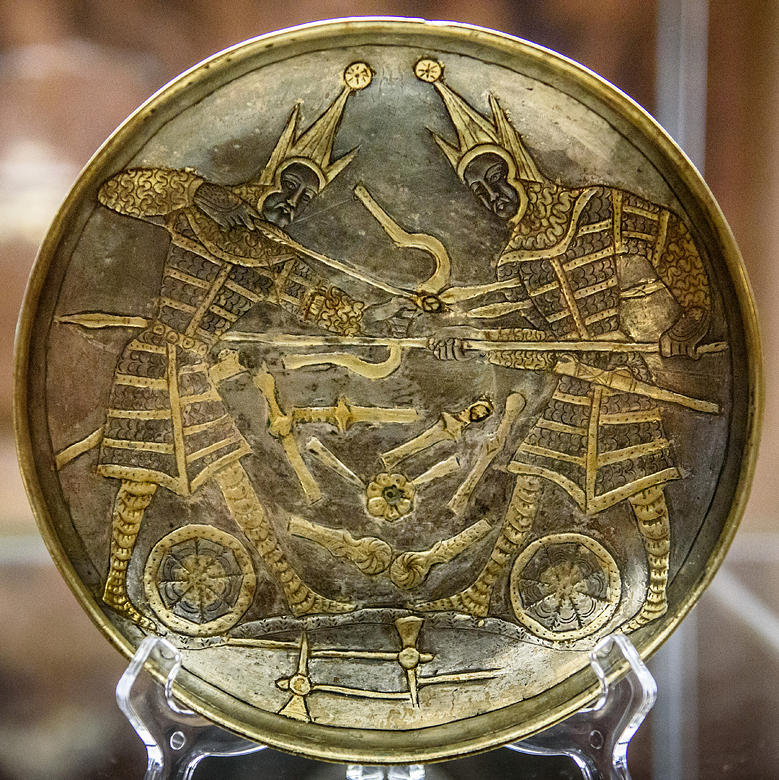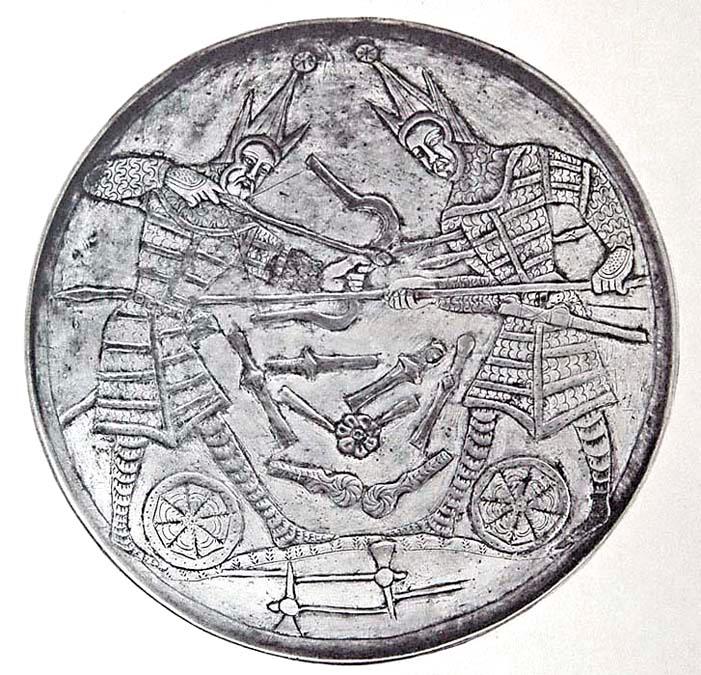
Join Amazon Prime - Watch Thousands of Movies & TV Shows Anytime - Start Free Trial Now
Dish, showing soldiers in winged helmets in combat
Post Sasanian Iran
Picture source




Dish, showing soldiers in combat.
Iran, post-sasanian. Silver. Dia: 22 cm. Found 1893, Kulagysh, Perm province, Russia.
Published: Smirnov no. 50.
Held by the State Hermitage Museum, St. Petersburg. Source
fig. 74, p 61, Bilderatlas zur Kunst und Kulturgeschichte Mittel-Asiens : vol.1 by Albert von Le Coq
Translated from the German:
Sasanian silver bowl (after Smirnoff).
Sassanid platelet armour, those found in Šōrčuq are apparently related replicas, but with sleeved-corslet of chain mail (mesh armour). Helmet: misunderstood representation of a winged helmet ? or unique type. Buckler, Turkish (?) recurved bow. Dagger (for lancer). Lance, various forms of clubs and daggers. Battleaxe.
Referenced as Illustration 31, p40 in Tamara Talbot Rice, Ancient Arts of Central Asia, 1965
31 Silver dish from Kulagysh showing two warriors deeply engaged in single combat. Their broken weapons lie scattered on the ground. Griaznov believes that the scene illustrates an incident from an ancient epic. Seventh century AD or later.
Siberian gold and bronze belt buckles & plaques, an extract from ANCIENT ARTS OF CENTRAL ASIA by Tamara Talbot Rice
Referenced Fig. 233 Mace head, in The Arts of the Muslim Knight The Furusiyya Art Foundation Collection, by Bashir Mohamed, 2008
A remarkable scene of battle depicted on a seventh-century Sogdian silver plate depicts a battle between two warriors with broken swords and maces, together with shields and spiked axe hammers strewn on the ground between them.1 Two of these have spiralling round heads and another is shaped like a large flower. This suggests that simpler forms of cylindrical mace heads, such as that cast with spiralling ribs in the collection, are continuations of older traditions.
1 Marschak 1986, pp. 284-85, no.198.
Referenced as figure 442 in The military technology of classical Islam by D Nicolle
442. Silver dish from Kulagysh, 7th-8th centuries AD, Khurāsāni or Transoxanian, Hermitage, Leningrad (Thor As Ric A).
The spread of lamellar armour from Central Asia across the Muslim world is altogether easier to chart. Its terminology is generally less contentious and the illustrated material is simpler to interpret. As discussed earlier: such a form of defence may have originated in the ancient Middle East but by the immediate pre-Islamic centuries lamellar armours of iron or a mixture of iron and bronze were far more characteristic of Central Asia and eastern Iran than the Fertile Crescent35 (Figs. 61, 67, 82, 428, 435, 437, 440, 443, 451, 453, 454, 455, 462, 463, 464, 471, 472, 474, 478, 480 and 481). There is, however, some evidence to suggest that they were known in 7th century Arabia, although they are likely to have been rare.36 Indeed, lamellar would seem to have been highly prized and expensive even in those Transoxanian regions where it was not common, and remained so well into the Muslim era.37
The increased importance of lamellar in eastern Islam and in the partially subdued Christian regions of the Caucasus is clearly documented as is its spread westward into Muslim Anatolia towards the end of the period under review38 (Figs. 220B, 306, 309, 316, 348, 410, 442, 444, 447, 638, 641 and 642C). References could be multiplied ten- or twenty-fold if one included all those concerning armours known to be of lamellar, such as the jawshan and kamarband, rather than simply those that described lamellar, its appearance, construction or fastenings.
35. Robinson, Oriental-Armour p. 130; Laufer, op. cit., pp. 208 and 214; W. Hauser, "The Persian Expedition, 1933-1934," Bulletin of the Metropolitan Museum of Art XXIX (1934), p. 8.
36. Schwarzlose op. cit., pp. 327 and 346.
37. Narshakhī, op. cit., p. 46; al Ṭabarī: op. cit., vol. II, pp. 256 and 1889.
38. Firdawsī, op. cit., pp. 270, 273, 427, 688 and 953; Anon., The Book of Dede Korkut, p. 166; Rust'haveli, op. cit., verse 220.
Used as a source for Plate B1, MAA - 125 - The Armies of Islam 7th-11th Centuries by David Nicolle & Angus McBride